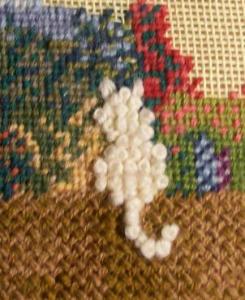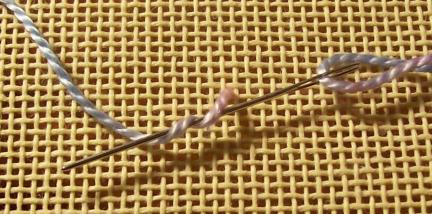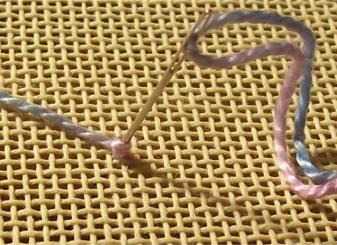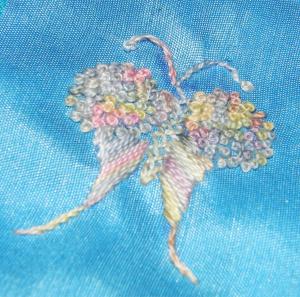- Home
- Basic embroidery stitches
- Stitch a French Knot
Tired of Tangled French Knots? Here’s the Secret to Making Them Tidy.
Sound familiar? You pull your needle through the fabric, expecting a neat, perky little dot, but instead you get... a tangle. A loose loop. A sad, droopy bump that looks more like tangled fishing line than an elegant stitch.
Believe me, I’ve been there. I used to stare at my hoop in defeat, wondering how everyone else made it look so easy while my work was a field of wonky knots.
If you’re feeling that frustration, let me tell you something: you don’t lack talent. You just haven’t been told the real secret yet.
It’s not about having “magic hands.” It’s about slowing down and giving yourself permission to doodle with knots.
 My early attempts. If your knots look like this, you're in the right place!
My early attempts. If your knots look like this, you're in the right place!The Breakthrough - From Rushing to Relaxing
My "aha!" moment didn't come from a fancy tool or a complicated tutorial. It came when I stopped trying to make a project and started to just play.
For 15 minutes each evening, I would just sit and make knots. No pressure. No pattern. I called it my knot-doodling time. Slowly, patiently, something started to click.
That simple, daily practice changed everything. And it can for you, too.
The Simple 4-Step Rhythm for Perfect French Knots
Let’s break down the motion that finally worked for me. Think of it as a gentle, four-step rhythm. I’ve used a chunky thread here so you can easily see what my hands are doing in the photos below the steps.
- Come Up for Air: Bring your needle up through the fabric exactly where you want your knot to live. Easy.
- Wrap, Don't Strangle: With your other hand, hold the thread taught (but not tight!). Wrap it once around your needle for a small knot, or twice for a slightly chubbier one.
- Find a New Home: Here’s the most important part! Insert the tip of your needle back into the fabric right next to where you came up, but not in the very same hole. Give it a little space—just a fabric thread or two away.
- A Slow, Gentle Pull: Keep holding the wrapped thread taut with your other hand as you slowly and smoothly pull the needle all the way through to the back. A nice, even motion is all you need.


That’s it! That’s the whole dance. Now Watch the slow, steady rhythm in action. No rushing needed!

My Top 3 French Knot Secrets (That Took Me Ages to Figure Out)
During my nightly knot-doodling sessions, I ran into every problem imaginable. These three little secrets were the ones that made the biggest difference.
Secret #1: Give Your Knot Some Space
My first hundred knots (slight exaggeration!) vanished the second I pulled them tight. They’d just slip right through the back of the fabric, leaving me with nothing but a hole and a bit of a grumble
When you put your needle back down (Step 3), never go back into the exact same hole you came out of. Moving over by just one or two threads of the fabric gives the knot something to grip onto, so it sits proudly on top.
It’s such a simple shift, but it’s the one that makes us feel like we’ve finally got control over where our stitches land. So satisfying!
Secret #2: Shorter is Sweeter
I used to think using a super long piece of thread would save me time. Instead, I spent most of my time untangling a bird's nest of knots behind the hoop. It was a mess.
Work with a shorter length of thread, about the length from your fingertips to your elbow (around 12-18 inches). It’s far less likely to tangle and makes maintaining even tension a breeze.
This little change makes the whole process so much more relaxing and joyful, because we spend more time stitching and less time fighting with our supplies.
Secret #3: Find a Little Mantra
My tension was all over the place because my mind would wander. Some knots were pebbles, others were droopy loops.
As you stitch, say a little three-part mantra to yourself: “Wrap… anchor… pull.” This simple verbal cue keeps your hands and mind focused on a steady, consistent rhythm.
It helps us build that muscle memory without even thinking about it, and soon we find ourselves making beautifully consistent knots, one relaxing stitch at a time.
Your Tidy Knots are Waiting
Two years ago, I would have avoided any pattern that had French knots. Now, they’re one of my favorite ways to add texture and detail.
 From tangled messes to tidy butterflies. This is what a little patient practice can do!
From tangled messes to tidy butterflies. This is what a little patient practice can do!Every wonky knot you make today is teaching your hands something. It’s not a sign of failure; it’s the foundation of your future skill.
The moment you see your first row of tidy, uniform knots is a special one. It doesn’t come from a flash of talent, but from the quiet, happy rhythm of patient practice.
The tangled-fishing-line days are behind me. With a little bit of doodling, they’ll be behind you, too.
Stay connected between projects
If you’d like occasional updates from my embroidery room, including new patterns, gentle tips, and little things I think you might enjoy, you’re warmly invited to join the Stitchin’ Times newsletter.
No pressure. Just a friendly note now and then to keep you inspired.


